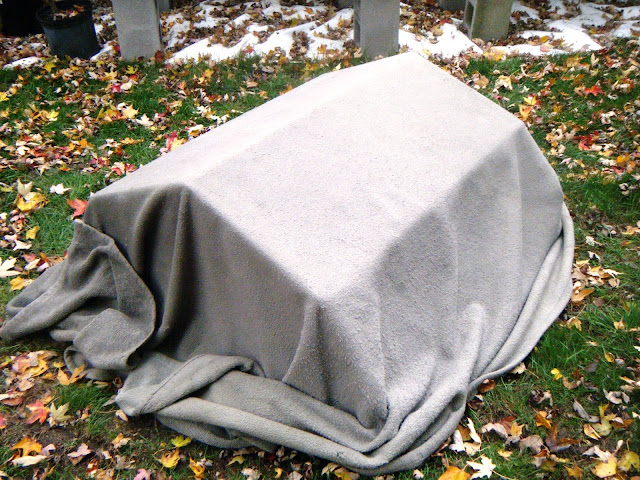This has been a busy summer and fall, and between one thing and another I (still!) did not have winter quarters ready for my tropicals when our first frost was predicted a week ago. The "tropical bonsai two-step" - taking the trees into the house for the nite and then back outside when things warm up enough the next day - is better than losing trees, but still a cumbersome process when you have more than two dozen tropicals of all sizes. And it does inconvenience my wife.
I've recently subscribed to Ryan Neill's weekly live-stream broadcast from Bonsai Mirai. The evening before the frost warning, in what I consider a little gift from God, Ryan mentioned something that for me was serendipitous. Plant tissues, he said, become endangered by cold at 28° F, not at 32° F (the freezing point of water), as one would expect. That's because water inside a tree's tissues doesn't freeze (creating ice crystals, which do the damage) until the air temperature outside the tree gets down to about 28° F. (For readers accustomed to Celsius, 28° F is equivalent to -2.22° C.)
That's partly because the outermost layers of bark and cuticle slow heat loss, partly because water itself has a high heat retention capacity, and partly because of the sugars, starches and other substances dissolved in the intra-tissue water, which lower its freezing point. (Any substance dissolved in water lowers its freezing point and raises its boiling point, to one degree or another. Anything.)
Overnite lows, while forecast to be at or near freezing, were not forecast to get down to 28° F. So the next day I decided to apply what I'd just learned, along with protection measures I already knew. The earth itself is a good heat reservoir, especially this early in the season. So I set up a small cold frame that I've had for about 30 years directly on the ground, with just a thin old sheet under it to keep the pots clean. Most of my tropical trees fit into it.
Overnite lows, while forecast to be at or near freezing, were not forecast to get down to 28° F. So the next day I decided to apply what I'd just learned, along with protection measures I already knew. The earth itself is a good heat reservoir, especially this early in the season. So I set up a small cold frame that I've had for about 30 years directly on the ground, with just a thin old sheet under it to keep the pots clean. Most of my tropical trees fit into it.
A few twigs got bent down when I put on the cover and a few leaves stuck thru the cracks, but those were minor considerations.
 |
| With the cover in place, heat loss thru radiation to the atmosphere is reduced a great deal. The white at the top of the picture is not snow, but a vinyl product that I'm using as a ground cover. |
For another layer of protection, I threw an equally old blanket over the cold frame and wrapped it against the sides.
 |
| The blanket traps another layer of dead air, and covers the gaps in the coldframe's construction, keeping out wind. |
It's been a week. When daytime temperatures have allowed, I've taken off the blanket and the frame's cover so the trees could get as much light as possible. That's especially important because, being tropicals, they are not genetically programmed for a dormancy period, and keep metabolizing even when they can't replenish their resources by photosynthesis.
A few of my smaller tropicals didn't fit under the frame. I've been doing the "tropical two-step" with them, but with just a few small trees it's not a major chore.
After tonite, temperatures are expected to warm up for the next 8-9 days, and the trees won't need this protection. Meanwhile, I've ordered a tent-like greenhouse that I will set up on our side porch, and fit with benches, lights, and other necessities to keep my tropicals happy thru the rest of the winter. Stay tuned.
:-) :-) :-)

A very nice cozy cold frame. I bring my tropical trees inside when there is a chance of frost, the tree may survive colder temperatures, but they will generally loose all the leaves due to frost. My problem is trying to fit all the trees inside. Each year, somehow I end up with more trees than I had at the start of the year! The trees also tend to grow a little larger each year and it is always a challenge to fit them back inside. Time to get out the pruners!
ReplyDeleteThanks for your comments, Nigel. As you saw in the post, this was an emergency situation, and I was just thankful that I had learned what I had learned and had measures available to protect the trees from any serious damage. I'll know in a few weeks, of course, just how well they came thru.
DeleteAs for the greater numbers and greater sizes - how *does* that happen? - I had to chuckle! I know exactly what you mean!